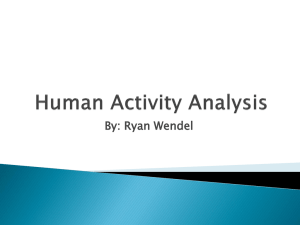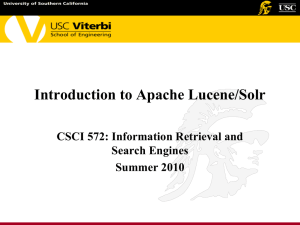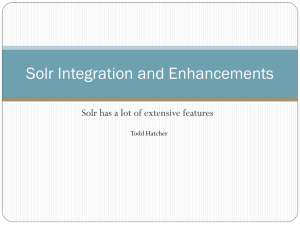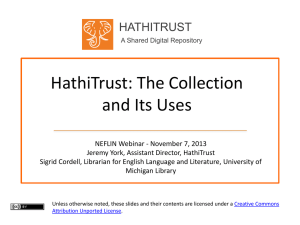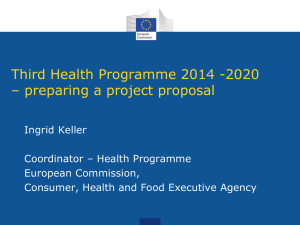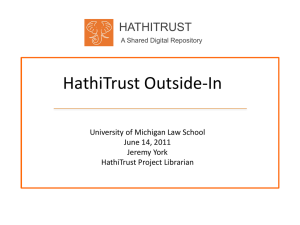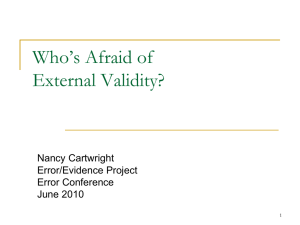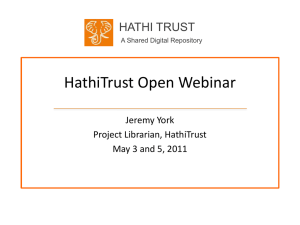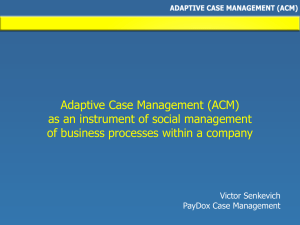Towards Practical Relevance Ranking for 10 Million
advertisement
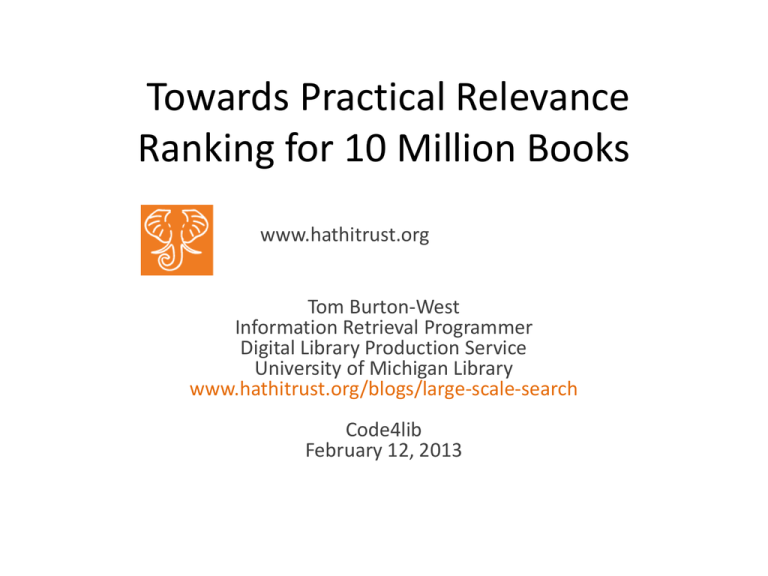
Towards Practical Relevance Ranking for 10 Million Books wwww.hathitrust.orgww.hathit rust.org Tom Burton-West Information Retrieval Programmer Digital Library Production Service University of Michigan Library www.hathitrust.org/blogs/large-scale-search Code4lib February 12, 2013 HathiTrust • HathiTrust is a shared digital repository • 70+ member libraries • Large Scale Search is one of many services built on top of the repository • Currently about 10.5 million books • 450 Terabytes – Preservation page images;jpeg 2000, tiff (438TB) – OCR and Metadata about (12TB) 2 Large Scale Search Challenges • Goal: Design a system for full-text search that will scale to 10 million -20 million volumes (at a reasonable cost.) • Challenges: – Multilingual collection (400+ languages) – OCR quality varies – Very long documents compared to IR research collections and most large-scale search applications – Books are different! Relevance Ranking Questions • How should MARC metadata fields be scored relative the full-text OCR? • How should we tune relevance ranking to properly accommodate book length documents? • If we break books down into smaller parts (chapters, sections, pages), how should the relevance scores for the parts be combined to rank the books? • How do we test any of the above in a principled way? Relevance Ranking for Books • HT average document size huge compared to IR research collections. • Solr’s default algorithm ranks very short documents much too high. • 2007 IBM TREC results: Modifications to Lucene ’s default length normalization resulted in relevance ranking comparable to state-of-the-art • Solr 4 implements a number of modern ranking algorithms which have parameters to allow tuning for document length characteristics. Long Documents • • Average HathiTrust document is 760KB containing over 100,000 words. – Estimated size of 10 million Document collection is 7 TB. Average HathiTrust document is about 30 times larger than the average document size of 25KB used in Large Research test collections – Over 100 times larger than TREC ad hoc Average Doc Size (KB) 800 700 600 500 400 300 200 100 0 HathiTrust ClueWeb09 (B) Collection Size Documents Average Doc size HathiTrust 7 TB 10 million 760 KB ClueWeb09 (B) 1.2TB 50 million 25 KB TREC GOV2 0.456 TB 25 million 18 KB TREC ad hoc 0.002 TB 0.75 million 3 KB HathiTrust (pages) 7 TB 3,700 million 2KB TREC Gov2 NW1000G Spirit TF*IDF ranking • Solr/Lucene’s relevance ranking formula is loosely based on the vector space model, which is one of the tf*idf families of ranking algorithms • TF = term frequency. – The more often a query term occurs in a document the more likely that the document is relevant. • IDF = inverse document frequency. – The fewer documents that contain a query term, the better the term is for discriminating between relevant and irrelevant documents • Length normalization – adjusts scores to account for different document lengths Solr’s aggressive Length normalization makes short documents rank too high • Search for the word “book” in HathiTrust • Highest ranked document contains just 4 words of OCR “The Book of Job” • Search for word “Dog” • 3 of top 5 documents contain less than 1,500 words. (Average doc contains 100,000) Preliminary tests with Solr 4 • Indexed 1 shard of data (850,000 docs)with 3 new algorithms (using default parameters) – BM25,DFR,IB – Compared with same data indexed with Solr/Lucene default algorithm • Preliminary tests – Ran a few queries and looked at top 10 results – None of these algorithms had the same problem as the default Lucene/Solr algorithm with very short documents – No other *obvious* difference in quality of results – Need more systematic testing! Parameter Tuning • Modern algorithms in Solr 4 have parameters to tune TF normalization and length normalization • Defaults based on training with short TREC documents (average 300-1600 words) unlikely to work for 100,000 word books • Need a training/test collection of books Complications: Dirty OCR • Dirty OCR can distort document statistics used in ranking – Taghva et. al. found that images misrecognized as text could increase the number of words in a document by 30%. – MaxTF or averageTF for a document can also be affected by dirty OCR Complications: Multiple Languages • Indexing all 400 languages in one index distorts IDF statistics – A query for [die hard] will use an IDF for “die” that includes the number of documents containing the German word “die” – A query for the Swedish word for ice “is” will use an IDF that includes the counts for documents containing the English word “is”. Books are Different: TF in Chapters vs Whole Book Montemuro and Zanette(2009) Books are Different: Should we index parts of books? • What unit should we use for indexing? – Whole book, chapters, sections, pages, other units? • Do user’s want a ranked list of books, or chapters or pages or snippets? – Depends on user need and context. • factual questions “ Capital of Canada” • big questions: “causes of the English civil war”, “relationship of fat in diet to serum cholestorol to heart disease. – Depends on type of document • Bound journals (2.5 million in HT) should be indexed by article • Dictionaries and encylopedias (over 100,000 in HT)should be indexed per entry • Reference books should also be indexed per entry (Bates 1986) Should we index parts of books? Practical issues • Chapter markup is based on OCR and likely unreliable. If 10% of volumes incorrectly partitioned, they would not be ranked correctly • Structural metadata based on OCR. Journal article boundaries, or encyclopedia entries, not marked up in metadata. • Instead of book chapters could try to segment by “Topic.” Should we index parts of books? Practical issues • We have good mark-up for whole volumes and pages, so we could index pages. • Will Solr scale to 3.7 Billion pages (with current hardware?) • Until recently Solr did not support part-whole relationships. “Field-Collapsing” could be used to group pages into books. Will it scale? INEX Book Track • INEX=INitiative for the Evaluation of XML retrieval. Book Track started in 2007 • Collection of 50,000 books with OCR and MARC data used for main book retrieval task 2007-2010 • Ongoing issues with low active participation rates and insufficient relevance judgments INEX Book Track • Questions investigated by the INEX Book Track participants – What is best unit to use in indexing? • Whole book, groups of pages, pages? • Considered chapters but no one used them! • Is best unit affected by query length? – What is the best way to combine page scores to rank books? • Ranking by highest ranking page in book not often the best – How to best to use OCR and MARC metadata in scoring. • Results contradictory and inconclusive – Could not tune algorithms for document length and collection characteristics without training corpus with judgments. – Several groups used ranking algorithms with defaults which were based on 300-1000 word TREC documents , not 100,000 word books. – Not enough relevance judgments! Tuning Relevance Ranking Current Method: Ad hoc relevance testing • • • • • Set some boost values try out some queries repeat until results look good Ask for user/librarian testing comments Much of the testing based on known item queries. Relevance Testing Plan • Create a representative set of queries • Improve live monitoring and testing – Query log metrics (click logs) – Framework for A/B testing with interleaving • Create a test collection Relevance Testing: Queries • We need a collection of test queries that reflect different types of user needs – Query log analysis – User studies – We can use the test queries for both more systematic ad hoc testing and as a basis for a test collection. • We will add click logging to our search logs – Allows some measure of how well our ranking is working • Click on top 3 hits • Various click/relevance models Testing Relevance • Online Evaluation and A/B testing – can only test two different algorithms at a time – risky if doing live testing – good for fine tuning but not for parameter sweep • Offline testing (Test collection) – Set of queries, Set of documents, Set of relevance judgments – Re-usable – Can test many algorithms with many parameter variations in batch mode Test Collection • Queries – Need sufficient number of representative queries • 50 -100 is probably the minimum. – Queries must address range of use cases/user needs • Collection of Documents – Need representative collection that is small enough to work with, but large enough to infer that results will apply to entire 10 million document collection Test Collection Relevance Judgments • Collecting Relevance judgments is labor intensive – TREC hires 8-10 retired intelligence analysts to do the judging – Sanderson (2010) estimated 75 person days for a typical 50 topic TREC track. (This is for short documents) – Kazai reports significantly more effort required for relevance judgments of books – Google and Bing hire many workers to make judgments Test Collection volunteers needed • If you are interested in helping to organize gathering relevance judgments from librarians and users, please contact me tburtonw@umich.edu Thank You ! Tom Burton-West tburtonw@umich.edu www.hathitrust.org/blogs/large-scale-search References • Doron Cohen, Einat Amitay and David Carmel. “Lucene and Juru at TREC 2007”: 1-Million Queries Track, TREC 2007, http://trec.nist.gov/pubs/trec16/papers/ibm-haifa.mq.final.pdf • Kazem Taghva, Julie Borsack, and Allen Condit. 1996. Evaluation of modelbased retrieval effectiveness with OCR text. ACM Trans. Inf. Syst. 14, 1 (January 1996), 64-93. DOI=10.1145/214174.214180 http://doi.acm.org/10.1145/214174.214180 • M. Montemurro and D. H. Zanette, The statistics of meaning: Darwin, Gibbon and Moby Dick, Significance, Dec. 2009, 165-169 • Bates, Marcia J. "What Is A Reference Book: A Theoretical and Empirical Analysis." RQ 26 (Fall 1986): 37-57. • INEX book track : https://inex.mmci.unisaarland.de/data/publications.jsp • Grant Ingersoll on Relevance testing: http://searchhub.org/2009/09/02/debugging-search-applicationrelevance-issues/ References • Solr/Lucene’s default ranking algorithm – • New ranking algorithms in Solr/Lucene 4.x – – • http://searchhub.org/2011/09/12/flexible-ranking-in-lucene-4/ http://lucene.apache.org/core/4_1_0/core/org/apache/lucene/search/similarities/packagesummary.html#package_description Solr field collapsing – – • http://lucene.apache.org/core/4_1_0/core/org/apache/lucene/search/similarities/TFIDFSimilarity.html http://wiki.apache.org/solr/FieldCollapsing http://www.searchworkings.org/blog/-/blogs/24078 Length Normalization – – – Amit Singhal, Chris Buckley, and Mandar Mitra. 1996. Pivoted document length normalization. In Proceedings of the 19th annual international ACM SIGIR conference on Research and development in information retrieval (SIGIR '96). ACM, New York, NY, USA, 21-29. DOI=10.1145/243199.243206 http://doi.acm.org/10.1145/243199.243206 http://singhal.info/pivoted-dln.pdf Abdur Chowdhury, M. Catherine McCabe, David Grossman, and Ophir Frieder. 2002. Document normalization revisited. In Proceedings of the 25th annual international ACM SIGIR conference on Research and development in information retrieval (SIGIR '02). ACM, New York, NY, USA, 381-382. DOI=10.1145/564376.564454 http://doi.acm.org/10.1145/564376.564454 Yuanhua Lv, ChengXiang Zhai. "Lower-Bounding Term Frequency Normalization". In Proceedings of the 20th ACM International Conference on Information and Knowledge Management (CIKM'11), pages 7-16, 2011. http://sifaka.cs.uiuc.edu/~ylv2/research.html References: Relevance Testing • Click logs and other online evaluation techniques – – – – • Side by side evaluation – • Olivier Chapelle, Thorsten Joachims, Filip Radlinski, and Yisong Yue. 2012. Large-scale validation and analysis of interleaved search evaluation. ACM Trans. Inf. Syst. 30, 1, Article 6 (March 2012), 41 pages. DOI=10.1145/2094072.2094078 http://doi.acm.org/10.1145/2094072.2094078 http://dl.acm.org/citation.c fm?id=2094078 Thorsten Joachims, Laura Granka, Bing Pan, Helene Hembrooke, Filip Radlinski, and Geri Gay. 2007. Evaluating the accuracy of implicit feedback from clicks and query reformulations in Web search. ACM Trans. Inf. Syst. 25, 2, Article 7 (April 2007). DOI=10.1145/1229179.1229181 http://doi.acm.org/10.1145/1229179.1229181 Practical Online Retrieval Evaluation, presented at SIGIR 2011.http://www.yisongyue.com/talks/sigir_tutorial_combined.pptx Practical and Reliable Retrieval Evaluation Through Online Experimentation, WSDM 2012 Workshop on Web Search Click Data, February 2012. http://www.yisongyue.com/talks/wsdm2012_interleaving.pptx Paul Thomas and David Hawking. 2006. Evaluation by comparing result sets in context. In Proceedings of the 15th ACM international conference on Information and knowledge management (CIKM '06). ACM, New York, NY, USA, 94-101. DOI=10.1145/1183614.1183632 http://doi.acm.org/10.1145/1183614.1183632 User studies – Diane Kelly. 2009. Methods for Evaluating Interactive Information Retrieval Systems with Users. Now Publishers Inc., Hanover, MA, USA. http://www.ils.unc.edu/~dianek/FnTIR-Press-Kelly.pdf References: Test Collections • • • • M. Sanderson. (2010) Test collection based evaluation of information retrieval systems. Foundations and Trends in Information Retrieval, 4:247--375, 2010. http://dis.shef.ac.uk/mark/publications/my_papers/FnTIR.pdf Ellen Voorhees and Donna Harman, editors. TREC: Experiment and Evaluation in InformationRetrieval. The MIT Press, 2005 Harman, Donna (2011) Information Retrieval Evaluation. Synthesis Lectures on Information Concepts, Retrieval, and Services, 3(2), 1–119. doi:10.2200/S00368ED1V01Y201105ICR019 http://www.morganclaypool.com/doi/abs/10.2200/S00368ED1V01Y201105ICR019 Google and Bing – – • http://searchengineland.com/interview-google-search-quality-rater-108702 http://www.youtube.com/watch?v=nmo3z8pHX1E Crowdsourcing relevance judgments – Gabriella Kazai, Natasa Milic-Frayling, and Jamie Costello. 2009. Towards methods for the collective gathering and quality control of relevance assessments. In Proceedings of the 32nd international ACM SIGIR conference on Research and development in information retrieval (SIGIR '09). ACM, New York, NY, USA, 452-459. DOI=10.1145/1571941.1572019 http://doi.acm.org/10.1145/1571941.1572019 – Gabriella Kazai’s publication list: http://www.gabriella-kazai.com/
